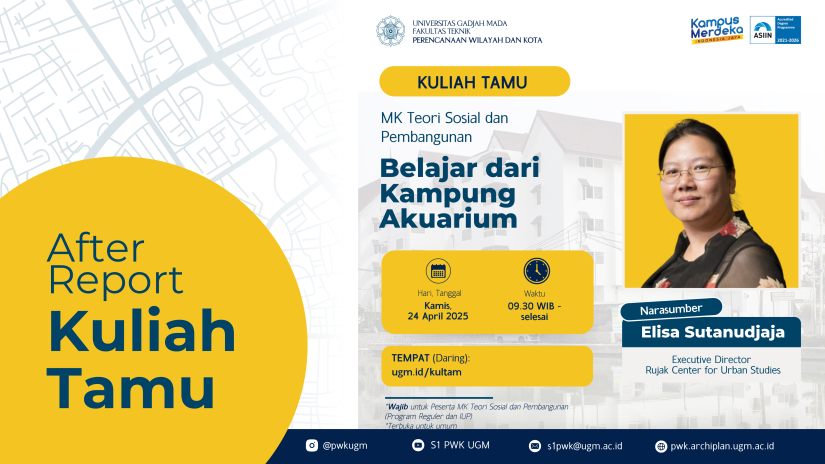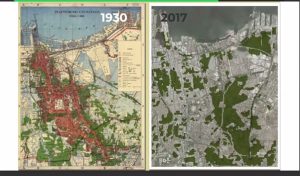
Yogyakarta, April 24, 2025 – The Undergraduate Program in Urban and Regional Planning once again held a guest lecture in collaboration with a practitioner, conducted on Thursday, April 24, 2025. This edition of the guest lecture carried the theme “Learning from Kampung Akuarium” in North Jakarta and featured Elisa Sutanudjaja, Executive Director of the Rujak Center for Urban Studies, as the invited speaker.
The lecture invited participants to explore valuable lessons from Kampung Akuarium—how the concept of community-based and inclusive kampung susun (vertical village housing) was implemented, along with the various dynamics faced before, during, and after its development.
The session began with an explanation of the concept of kampung kota, or urban kampungs. These are socially formed and non-market-driven settlements located in strategic urban areas. Urban kampungs are built on community independence—residents often construct their own infrastructure with limited or no government support. While often stigmatized as “slum areas,” not all kampungs fit this label. One of their key characteristics is a rich social structure, often reflecting diverse ethnic backgrounds, much like informal settlements. Kampung Akuarium, for instance, is known for its social diversity, earning it the nickname “Miniature Indonesia.” Yet this complexity is often used as justification to label it as a slum.
Urban development should not be merely about constructing lifeless buildings—it should be about creating living spaces. Cities are dynamic and continuously evolving, so labeling them as either successful or failed is an oversimplification. A city is a process, not a finished product. One of the core issues in Indonesian planning is the tendency to regulate even the smallest residential spaces, often through top-down policies like building rusunawa (low-cost rental apartments) for the sake of easier monitoring. However, this approach overlooks the need for spaces where people can socialize, grow, and thrive. Kampung susun, as a manifestation of kampung kota, differs greatly from rusunawa in terms of funding, approach, and design. Both kampung susun and kampung kota have their own unique strengths—such as proximity to workplaces, affordable transport, social cohesion, economic dynamism, and residents’ skills and resources.
The topic of this guest lecture aligns with several Sustainable Development Goals (SDGs), including:
-
SDG 8: Decent Work and Economic Growth
-
SDG 10: Reduced Inequalities
-
SDG 11: Sustainable Cities and Communities
-
SDG 17: Partnerships for the Goals
The key takeaway is that communities must be empowered. Urban planning and development should be just and equitable—not merely about drawing strict lines between right and wrong, but about understanding broader and deeper contexts. Planning must be future-oriented and inclusive.
The lecture was warmly received and met with great enthusiasm from participants, including students of the Urban and Regional Planning Undergraduate Program at UGM as well as members of the general public.
Source: https://pwk.archiplan.ugm.ac.id/after-report-kuliah-tamu-belajar-dari-kampung-akuarium/

